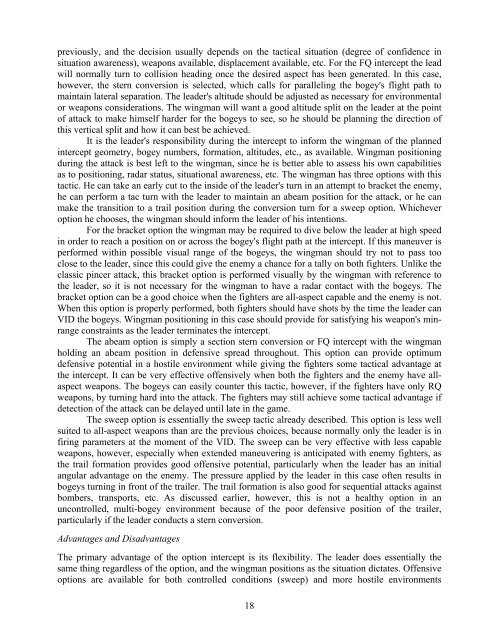Tactical Intercepts.pdf - e-HAF
Tactical Intercepts.pdf - e-HAF
Tactical Intercepts.pdf - e-HAF
You also want an ePaper? Increase the reach of your titles
YUMPU automatically turns print PDFs into web optimized ePapers that Google loves.
previously, and the decision usually depends on the tactical situation (degree of confidence in<br />
situation awareness), weapons available, displacement available, etc. For the FQ intercept the lead<br />
will normally turn to collision heading once the desired aspect has been generated. In this case,<br />
however, the stern conversion is selected, which calls for paralleling the bogey's flight path to<br />
maintain lateral separation. The leader's altitude should be adjusted as necessary for environmental<br />
or weapons considerations. The wingman will want a good altitude split on the leader at the point<br />
of attack to make himself harder for the bogeys to see, so he should be planning the direction of<br />
this vertical split and how it can best be achieved.<br />
It is the leader's responsibility during the intercept to inform the wingman of the planned<br />
intercept geometry, bogey numbers, formation, altitudes, etc., as available. Wingman positioning<br />
during the attack is best left to the wingman, since he is better able to assess his own capabilities<br />
as to positioning, radar status, situational awareness, etc. The wingman has three options with this<br />
tactic. He can take an early cut to the inside of the leader's turn in an attempt to bracket the enemy,<br />
he can perform a tac turn with the leader to maintain an abeam position for the attack, or he can<br />
make the transition to a trail position during the conversion turn for a sweep option. Whichever<br />
option he chooses, the wingman should inform the leader of his intentions.<br />
For the bracket option the wingman may be required to dive below the leader at high speed<br />
in order to reach a position on or across the bogey's flight path at the intercept. If this maneuver is<br />
performed within possible visual range of the bogeys, the wingman should try not to pass too<br />
close to the leader, since this could give the enemy a chance for a tally on both fighters. Unlike the<br />
classic pincer attack, this bracket option is performed visually by the wingman with reference to<br />
the leader, so it is not necessary for the wingman to have a radar contact with the bogeys. The<br />
bracket option can be a good choice when the fighters are all-aspect capable and the enemy is not.<br />
When this option is properly performed, both fighters should have shots by the time the leader can<br />
VID the bogeys. Wingman positioning in this case should provide for satisfying his weapon's minrange<br />
constraints as the leader terminates the intercept.<br />
The abeam option is simply a section stern conversion or FQ intercept with the wingman<br />
holding an abeam position in defensive spread throughout. This option can provide optimum<br />
defensive potential in a hostile environment while giving the fighters some tactical advantage at<br />
the intercept. It can be very effective offensively when both the fighters and the enemy have allaspect<br />
weapons. The bogeys can easily counter this tactic, however, if the fighters have only RQ<br />
weapons, by turning hard into the attack. The fighters may still achieve some tactical advantage if<br />
detection of the attack can be delayed until late in the game.<br />
The sweep option is essentially the sweep tactic already described. This option is less well<br />
suited to all-aspect weapons than are the previous choices, because normally only the leader is in<br />
firing parameters at the moment of the VID. The sweep can be very effective with less capable<br />
weapons, however, especially when extended maneuvering is anticipated with enemy fighters, as<br />
the trail formation provides good offensive potential, particularly when the leader has an initial<br />
angular advantage on the enemy. The pressure applied by the leader in this case often results in<br />
bogeys turning in front of the trailer. The trail formation is also good for sequential attacks against<br />
bombers, transports, etc. As discussed earlier, however, this is not a healthy option in an<br />
uncontrolled, multi-bogey environment because of the poor defensive position of the trailer,<br />
particularly if the leader conducts a stern conversion.<br />
Advantages and Disadvantages<br />
The primary advantage of the option intercept is its flexibility. The leader does essentially the<br />
same thing regardless of the option, and the wingman positions as the situation dictates. Offensive<br />
options are available for both controlled conditions (sweep) and more hostile environments<br />
18
















